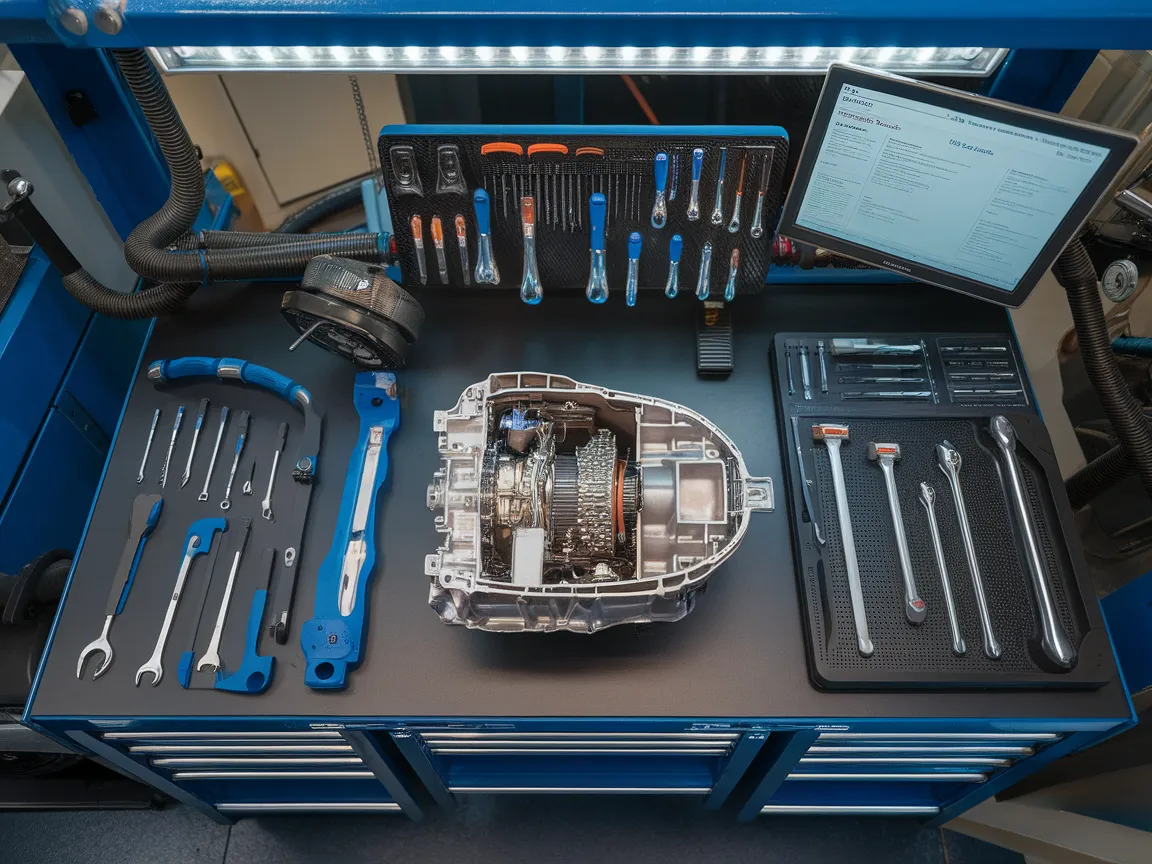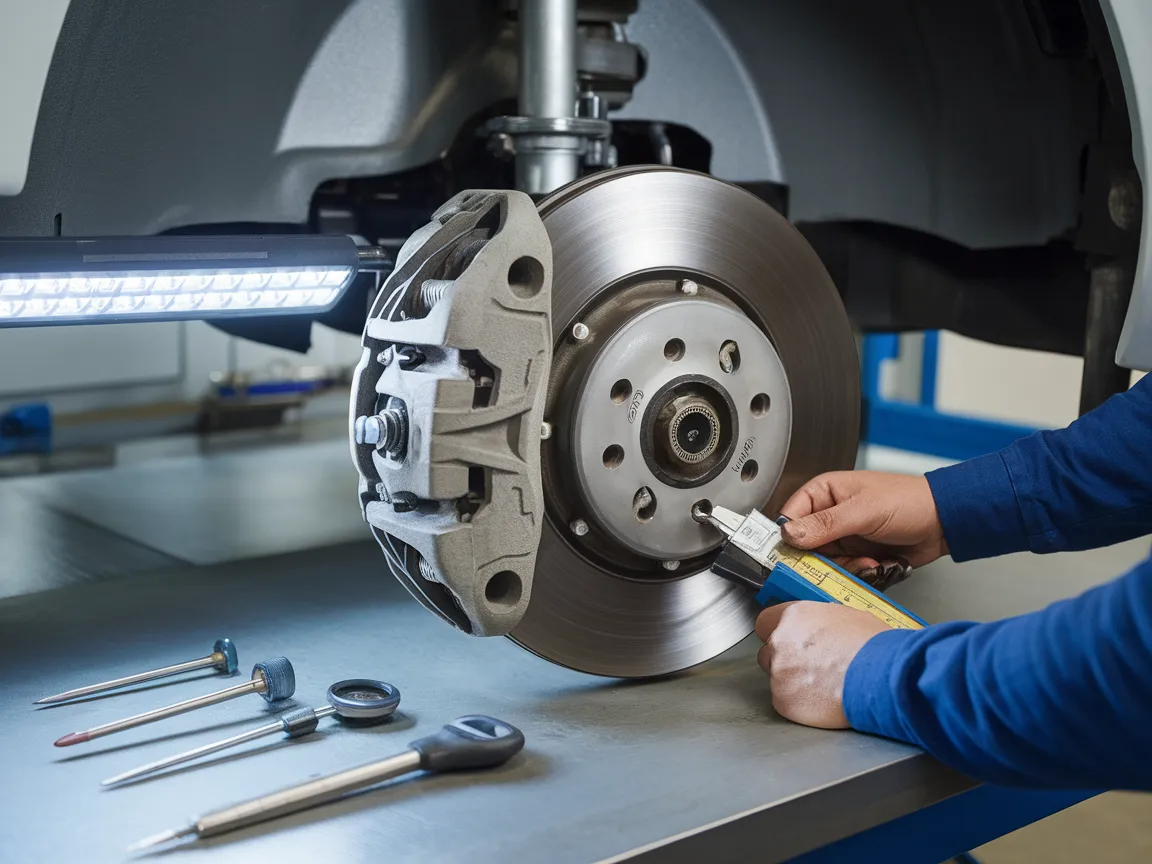To ensure your vehicle operates reliably and securely, it's essential to get general mechanical maintenance. Commence with routine maintenance including checking fluid levels and checking tire pressure. Be sure to change your oil every 5k-8k miles and keep track of brake fluid status. Get to know essential engine and transmission parts to identify concerns early. Always inspect the braking components and suspension for deterioration. Utilize digital applications for service monitoring and diagnostics to avoid unexpected issues. Look for professional technicians with ASE-certified staff and modern diagnostic gear for quality repairs. Looking ahead, understanding advanced repair methods might be your next step.
Essential Points
- Routine maintenance, particularly engine oil replacement and tire pressure checks, is essential for vehicle longevity and optimal operation.
- Periodic brake checks and fluid maintenance ensure safety and avoid major issues.
- Understanding engine components and typical issues aids in proactive auto care.
- ASE-recognized specialists offer expert service assurance for vehicle repairs and servicing.
- Electrical system diagnostics detect functionality concerns and demand specialized skills for complex problems.
Important Vehicle Repair and Upkeep Services
Regarding crucial car service and maintenance, understanding regular service intervals is crucial to ensuring your vehicle running smoothly. By following a preventive maintenance plan, you'll ensure long-term vehicle operation and reliability.
Commence with daily vehicle checks and consistent checks of fluid conditions and tire inflation. These basic tasks can avoid bigger issues in the future. Be sure to assess the brake system and arrange oil changes at the recommended intervals. Furthermore, update filters and examine belts and hoses to minimize unplanned breakdowns.
Embrace digital maintenance tracking to improve your efforts. Digital service alerts and digital maintenance records help you manage your vehicle's needs.
Instant diagnostics and tailored maintenance intervals enable accurate scheduling, improving your vehicle's longevity. Maintenance task management ensures nothing is overlooked, providing assurance.
Getting to Know Your Vehicle's Essential Mechanisms
To successfully manage your vehicle, it's essential to comprehend its key mechanical systems and typical challenges.
Gain knowledge of engine system operations, the basics of drivetrain mechanics, and the importance of periodic brake servicing.
Additionally, understanding chassis systems, as well as electrical troubleshooting, will empower you to prevent issues before they arise.
Engine Components and Common Issues
Familiarity with your vehicle's mechanical elements is vital for keeping optimal operation and preventing costly repairs. Let's explore the engine components and common issues.

The engine block is vital as it houses the cylinders where combustion occurs. The cylinders' pistons change fuel energy to mechanical energy. The crankshaft then transforms this linear motion into circular motion, moving your car ahead.
The valvetrain serves a vital function in regulating the coordination of air and fuel intake and regulating exhaust gas release. This involves a sophisticated arrangement of valves, springs, and camshafts, maintaining efficient engine operation.
Common engine problems can appear in various ways. Starting issues often suggest problems with electrical or fuel systems—check the fuel pump, battery, and starter motor.
Engine performance concerns like misfires or rough running may be caused by worn spark plugs, clogged fuel injectors, or damaged oxygen sensors.
Engine overheating commonly occurs, generally due to malfunctioning thermostats, failing water pumps, or coolant leaks. Be vigilant for warning signs like strange sounds or physical signs such as excessive exhaust smoke.
Regular maintenance, including proper oil and air filter maintenance, is crucial for avoiding these problems.
Understanding Transmission and Drivetrain
Understanding the core aspects of your vehicle's transmission and drivetrain is key to ensuring seamless power delivery and overall performance. The powertrain, comprising both engine and drivetrain, changes the engine's output into regulated movement.
At the heart of this system, the transmission manages power delivery, adjusting two basic types: stick shift, requiring clutch and gear input, and automatic, which automatically controls gear changes via hydraulic systems.
When dealing with automatic transmissions, the torque converter serves a critical role by joining the engine to the transmission. It improves torque output through hydraulic multiplication, making certain energy is transferred efficiently.
The driveshaft, crafted from durable materials like steel or aluminum, transmits rotational force from the transmission to the differential, utilizing constant-velocity joints for seamless operation.
Understanding the differential is crucial; it permits wheels to rotate at different speeds during turns, preserving power delivery, specifically in vehicles with multiple driven wheels.
Axles connect the wheels to the differential, varying in configuration based on vehicle specifications.
To maintain peak performance, routine upkeep and checking of these components are essential, improving fuel efficiency and stopping costly repairs.
Brake System Maintenance
Understanding the sophisticated world of brake system maintenance safeguards both safety and performance on the road. Your vehicle's brake system is a complex array of components such as brake pads, rotors, calipers, brake lines, and fluid. Every element demands careful monitoring for optimal operation.

Periodic examinations, optimally performed once a year or more often depending on your driving conditions, are crucial for early problem detection.
Brake fluid maintenance is essential as it accumulates moisture, causing decreased performance and corrosion. Change it every 24-36 months or 30,000 miles. In addition, monitor brake pads—they wear down naturally and typically should be replaced between 25,000 and 70,000 miles.
Watch for warning signs like strange noises—such as squealing, grinding, or metal-on-metal sounds—and physical indicators including a spongy brake pedal, car drifting to one side, pedal vibrations, or longer stopping distances. These signs need immediate attention from a professional technician.
Periodic checks consists of monthly brake fluid inspections and pad thickness measurements. Additionally, practice smooth braking techniques and avoid riding the brakes.
Understanding Suspension and Steering Parts
Mastering the intricate elements of suspension and steering is fundamental for ensuring your vehicle's reliability and handling. Your suspension system depends on various springs—including coil, leaf, torsion bars, and air—to bear the vehicle's weight and absorb impacts.

Control mechanisms such as struts, shock absorbers, bushings, and control arms control wheel travel and minimize vibration. Together, these parts steady your ride, optimizing comfort and handling.
In steering, critical elements include the rack and pinion, steering wheel, column, ball joints, and tie rods. Power assist systems—whether hybrid, hydraulic, or electric—deliver necessary assistance, making turning the wheel smoother and more accurate.
Recognizing signs of issues is critical. If you notice steering difficulties, excessive bouncing, or uneven tire wear, these could point to suspension or steering issues.
Regular inspections are essential. Examine bushings, shock absorbers, and power steering fluid levels regularly. Resolve any strange sounds or vehicle pulling without delay.
Periodic alignment checks and servicing of moving parts can avoid long-term damage. By knowing and servicing these systems, you ensure predictable braking, consistent road contact, and a smoother driving experience, ultimately boosting your vehicle's performance and overall safety.
Electrical System Diagnostics
Understanding the intricacies of your vehicle's electrical system plays a vital role in ensuring peak performance and safety. Contemporary cars are built around these systems for everything from engine control to entertainment, making diagnostics an essential competency.
Equip yourself with the essential tools: a digital multimeter for measuring electrical parameters; diagnostic scan tools for interpreting system alerts; and scope meters for examining signal patterns.
Initiate diagnostics by documenting symptoms and visually inspecting components for wear and deterioration. A systematic approach begins with a battery health check, continuing with charging system verification and earth point validation.
Circuit protection inspection are crucial to identify any power flow interruptions. Frequent problems often involve the cranking system, such as battery deficiencies or starter mechanism issues, and charging system faults like power supply inconsistencies.
Professional procedures, like electrical pattern reading and parasitic draw testing, help unravel complex issues. For ECU testing, verify ECU communication and monitoring system operation are intact.
Preventive care, including battery terminal cleaning and wiring system checks, remains vital. Request expert assistance for complex or safety-related problems, keeping service records to monitor problem patterns and verify proper repairs.
Finding the Right Auto Repair Service
When looking for a reputable auto repair service center, make sure to focus on businesses with ASE-accredited specialists to ensure you receive professional service.
Take time to examine the service warranty terms to comprehend what coverage comes with the work.
Be sure to assess tools and diagnostic systems, together with service rates and customer care, to identify the best match for your car service needs.
The Essentials About ASE Certification
Finding a professional auto repair shop may seem daunting, but knowing about ASE certification simplifies your decision. ASE certification, issued by the National Institute for Automotive Service Excellence, serves as the automotive industry's benchmark for technical proficiency.
When evaluating a shop, look for the blue ASE seal and technicians wearing ASE patches. These symbols show that the technicians have met rigorous standards through comprehensive testing in particular areas like electrical systems, engine repair, and brake service.
Technicians earn ASE certification by finishing two years of on-the-job training or pairing one year of experience with a two-year automotive degree, then passing focused exams. To maintain certification, they must requalify every five years, ensuring they stay updated with the latest automotive technology.
This commitment to continuous education guarantees that certified technicians are able to competently diagnose and repair modern vehicles' advanced systems.
Master ASE Certification goes beyond, calling for technicians to succeed in multiple tests across diverse specialties, proving their complete expertise.
Understanding Service Warranties
Understanding the details of service warranties is crucial when choosing a professional auto repair shop. It's important to understand the varieties of warranties—factory and extended—to make sure your vehicle receives the right coverage.
Factory warranties, included with new vehicles, usually offer bumper-to-bumper and powertrain coverage for specific timeframes. In contrast, extended warranties deliver optional protection following factory terms and can be adapted to include benefits like roadside assistance.
When evaluating a warranty provider, prioritize those with BBB accreditation, straight-to-shop payments to repair shops, and multiple repair facility choices. Ensure they offer clear terms and transparent pricing, which will shield you against unexpected costs.
It's crucial to know what's included and not included—mechanical and electrical problems are typically covered, while routine upkeep and standard deterioration are not.
To maximize your warranty benefits, keep detailed service records and comply with the manufacturer's maintenance schedule. This guarantees smooth claims processing and helps avoid disputes.
As you choose a repair shop, search for one that provides comprehensive warranty options, keeps clear documentation, and maintains open communication, guaranteeing your vehicle is in qualified hands.
Technical Standards and Equipment
When selecting a qualified auto repair shop, you must examine technical capabilities and equipment, guaranteeing your vehicle gets excellent care.
The shop should have essential safety apparatus, comprising protective wear and fire protection measures. These items protect both service staff and your vehicle.
Look for sturdy vehicle lifting systems, like vehicle hoists and motor lifts, which are crucial for secure and effective repairs.
Assess their diagnostic tools. Modern shops should utilize diagnostic scanners, digital inspection software, and alignment measurement systems to properly assess vehicle concerns.
Advanced service tools like fluid handling equipment and precision tools like brake lathes and tire changers are critical for thorough services.
Verify digital system integration with shop management systems that streamline workflows, parts management, and customer service. This provides productivity and clarity.
Service standards are non-negotiable; the shop should maintain equipment maintenance protocols, featuring periodic adjustments and safety checks, meeting technical specifications and compliance standards.
Price Comparison Strategies
Navigating the intricacies of auto repair costs demands a systematic approach to verify you're getting the optimal return for your money. Start with conducting an thorough assessment of your vehicle's details and current concerns. This guarantees you receive accurate quotes. Record all symptoms, warning lights, and sounds; this documentation helps mechanics to deliver accurate estimates and avoids unnecessary diagnostic fees.
When ready, obtain at least three estimates from reliable shops. Comparing quotes helps you identify both excessive charges and suspiciously low offers that may signal poor quality service. Examine material quality, labor costs, warranty coverage, and included additional services. Look for discrepancies in diagnostic fees and service details.
Quality matters, so evaluate each shop's reputation by checking testimonials, checking certifications, and observing cleanliness. Evaluate parts quality, whether factory, replacement, or remanufactured, as this influences reliability.
Finally, consider extra perks like warranties, free inspections, or courtesy vehicles. When deciding, analyze total costs, including long-term reliability and convenience. Research price matching and service bundling opportunities for discounts.
This meticulous approach ensures you pick a shop offering dependable repairs at a reasonable price.
Professional Service Criteria
When evaluating a reputable auto repair shop, prioritizing excellent customer service standards is essential to guaranteeing a rewarding and reliable experience.
Start by assessing their communication excellence. A premium shop will explain complex repairs into clear explanations, steering clear of technical jargon that might be unclear. They need to be upfront about pricing, presenting detailed estimates in advance and alerting you of any extra services required.
Evaluate their quality standards by seeking reliable workmanship and mechanical knowledge. Licensed professionals should be employed, regularly updating their skills to handle modern vehicles. This ensures correct troubleshooting and high-quality repairs, following manufacturer specifications.
Consider the customer experience as well. A quality shop keeps well-maintained premises with welcoming customer areas, reflecting care and attention to service. Complete records of service records, estimates, and repair authorizations should be readily available, establishing confidence.
Professional care includes proactive maintenance advice and continued assistance to address any post-repair concerns.
DIY vs Professional Auto Repair Decision Making
Determining if you should tackle auto repairs yourself or consult a professional represents a significant consideration that influences both your budget and the longevity of your vehicle.
When it comes to basic tasks like common maintenance procedures, DIY is usually a viable option. These tasks only require basic tools including common garage tools.
However, safety should be your priority; always use proper vehicle support equipment and don't position yourself under a car supported solely with jacks.
On the other hand, advanced engine diagnostics, transmission work, and safety-critical repairs should be left to professionals. Professionals have the benefit of specialized equipment and factory training, ensuring the job is done right.
They provide access to manufacturer resources and warranty coverage, which are crucial for preserving your vehicle's integrity.
Consider the cost-benefit analysis: while DIY repairs save on labor Emergency Repairs costs and allow for schedule flexibility, professional services provide advanced diagnostics and warranty coverage.
When in doubt about your ability to safely and correctly complete a repair, consulting a professional mechanic is wise.
Your decision should consider safety, expertise, and resource availability to ensure peak vehicle performance.
Automotive Repair Learning Tools
When considering the choice between DIY and professional auto repairs, knowing about the available resources for training and assistance can influence your choice.
YouTube offers a treasure trove of visual tutorials, with content creators like ChrisFix and Eric The Car Guy offering detailed videos on everything from basic oil changes to advanced engine repairs. These materials are essential whether you're just starting.
Online communities like Reddit's MechanicAdvice and the CarTalk Community let you tap into a wealth of shared knowledge. You can request guidance, solve problems, and share experiences with other DIYers and experts.
These resources excel at solving particular repair problems through community support.
Utilizing professional repair manuals is crucial for accuracy. Resources like Chilton and Haynes offer comprehensive, model-specific instructions that confirm you're following the correct procedures.
ALLDATAdiy provides latest technical service bulletins and OEM specifications, enhancing repair precision.
For organized learning, services offering ASE Certification prep and manufacturer-specific training programs can enhance your technical expertise.
Integrate these with digital parts identification tools like AutoZone's parts finder for a complete repair journey, guaranteeing you have the correct components for every job.
Effective Communication with Vehicle Professionals
Clear communication with auto repair professionals is essential to make sure you receive exact and effective service. Begin by understanding basic automotive terms. Understanding terms related to vehicle systems like cylinders and pistons, and mechanical systems such as drivetrain and chassis, helps you discuss issues clearly. Recognizing the indications of warning lights is also essential.
When describing problems, be detailed and accurate. Note when and where the problem occurs, including particular conditions like environmental factors. Note strange sensory indicators. Use position descriptions, explain issues without diagnosing, and mention the timing and frequency of issues.
Documentation plays an important role in guaranteeing smooth service. Keep records of your vehicle's service records, earlier services, and routine upkeep. Verify you have formal consent, detailed cost estimates, and component guarantees.
Don't hesitate to ask questions. During the first discussion, ask about repair timelines, cost breakdowns, and parts quality. Ask for status reports and new discoveries during the service.
This forward-thinking approach not only explains the process but also aids in understanding preventive maintenance recommendations. By adhering to these principles, you'll develop productive communication and enhance service outcomes.
Financial Planning for Repairs
Grasping the intricacies of auto repair costs is equally crucial to maintaining clear communication with repair professionals. Start with a comprehensive analysis, breaking down repairs into components, evaluating parts, labor, overhead, and diagnostic time. This detail-oriented approach confirms you account for all financial elements.
Alternatively, implement a triple-estimate approach, calculating optimistic, pessimistic, and realistic scenarios to calculate a weighted average. This approach delivers a complete view of potential expenses.
Investigate insurance options to manage costs. Standard coverage like comprehensive and collision coverage can minimize unforeseen costs, while additional coverage options offer further safeguards through original equipment coverage or independent protection plans.
Assess these choices against your service demands and coverage conditions.
Examine payment plans and financing to handle maintenance costs efficiently. Traditional financing, like lending products or charge accounts, delivers versatility, while other options such as installment payment plans or emergency repair funds provide further choices.
Essential Service Strategies
Your vehicle's longevity can be greatly increased through a well-planned maintenance approach.
Implement scheduled service intervals between 5,000 and 8,000 miles or about every six months. Minor services include oil and filter changes, checking fluid levels, rotating tires, and routine examinations.
Every 15,000 miles, perform intermediate services with comprehensive vehicle checks and refresh transmission fluid and air filters. Every 30,000 miles, tackle major services like spark plug and brake fluid replacement, along with cabin air filter and differential oil replacement.
Fluid maintenance is essential. Consistently replace engine oil at 5,000-8,000 mile intervals.
Transmission fluid needs replacement at 30,000-mile intervals to prevent wear. Replace brake fluid at two-year or 25,000-mile intervals, and change coolant every 30,000 miles or two years to prevent overheating.
Follow filter replacement guidelines: Engine air filters every 15,000 miles and replace cabin filters at 30,000-mile intervals.
Install new oil filters with each oil service.
For wheel care, perform tire rotation every 5,000 to 8,000 miles, verify alignment yearly, and check tire pressure every month.
Periodically examine battery connections for oxidation, assess battery condition, and maintain clean terminals to guarantee reliable operation.
Urgent Vehicle Repair Services
Even though routine upkeep preserves your vehicle in optimal performance, unexpected breakdowns can still happen. That's where urgent vehicle assistance become essential. With all-hours service availability, you're consistently supported. This includes holiday and weekend coverage, providing assistance whenever needed.
A immediate response number enables direct access, and with multi-language support, it's available to international drivers. Service area networks extend to both metropolitan and rural regions, delivering major road coverage. Even cross-border assistance is accessible, with guaranteed response times delivering rapid support.
Common roadside services covers jump-start service, tire change service, emergency fuel delivery, key assistance, and initial mechanical checks. Protection procedures like emergency vehicle positioning and emergency light activation guarantee your safety while waiting.
Vehicle recovery services includes wheel-lift and flatbed transport, supporting even heavy-duty vehicles. Professional handling and careful handling avoid further damage.
Interim mobility options include rental vehicles, ride-hailing assistance, and shuttle services. Furthermore, housing help can arrange overnight accommodation and offer vehicle storage solutions.
In crisis situations, these thorough solutions guarantee you're back on the road securely and promptly, limiting interruption and maintaining peace of mind.
Digital Automotive Care System
You can streamline your vehicle maintenance by utilizing digital auto service management tools.
Web-based maintenance planning and electronic service documentation keep your service needs organized and easy to retrieve.
Through remote diagnostic services and vehicle care applications, you stay updated and notified of upcoming service requirements, providing reliable and organized car service management.
Digital Service Booking
Modern automotive service solutions modernizes the way customers and auto repair shops handle appointment scheduling. By shifting from traditional phone-based methods to digital solutions, customers can schedule services 24/7 through websites or social media, seeing immediate time slot openings. This assures you pick the most convenient time for your service.
Offering detailed service selection, featuring in-depth information, you're updated at each stage.
Online appointment platforms enhances customer management by streamlining booking verification and maintaining car details, preventing booking mistakes. It aligns scheduling systems, allowing seamless staff scheduling, work assignment, and bay capacity management. This efficiency ensures service time is effectively managed, reducing delays.
For auto repair shops, web-based appointment management decreases telephone distractions, optimizes scheduling processes, and maximizes operational efficiency through automated reminder systems. This not only enhances operational efficiency but also improves service quality by enabling independent appointment setting, automated reminders, and flexible booking modifications if necessary.
Electronic Vehicle Service Records
In the dynamic landscape of automotive maintenance, digital vehicle history records are transforming the way maintenance data is handled and retrieved. By replacing traditional paper logbooks to secure electronic documentation, you can now track your vehicle's maintenance records with ease. This centralized database records all repairs, maintenance, and service tasks with precise timestamps, ensuring a transparent and verifiable history that follows your vehicle throughout its lifetime.
You'll discover that digital service records deliver improved visibility, allowing you to remotely access your vehicle's complete service history. This creates trust between you and your service provider.
Additionally, the reliability of digital systems prevents manual entry errors, offering a standardized documentation format that ensures consistent record-keeping across different service providers.
For future planning, digital records assist in monitoring and plan maintenance needs, ensuring timely service intervals and eliminating missed opportunities. As a result, your vehicle's resale value can notably benefit from a well-documented history, demonstrating proof of proper maintenance.
Whether through branded solutions like Mercedes-Benz DSB or through independent workshops with manufacturer-approved systems, you're guaranteed thorough documentation, no matter where service is performed.
This movement towards digitization offers enhanced information protection and improved compatibility with modern vehicle technology.
Digital Vehicle Diagnostics
Expanding from the basis of digital vehicle history records, connected diagnostic solutions advance automotive maintenance to the next level by leveraging IoT and connected technologies. With these solutions, you can track and identify vehicle issues without a physical inspection. Through diagnostic sensors and IoT sensors, your vehicle transmits real-time data about its system health, operational indicators, and emerging concerns.
Core components include devices like monitoring systems, IoT sensors, data transmission units for data transmission, and edge computing devices. Software systems support these with continuous observation tools, diagnostic analysis tools, preventive analysis systems, and vehicle management dashboards.
The main capabilities are real-time monitoring and preventive care. You'll benefit from real-time performance tracking, operational metrics gathering, vehicle condition evaluation, and immediate alert generation. Preventive servicing enables timely concern discovery, operational trend evaluation, and maintenance scheduling optimization to anticipate component failures.
For auto repair shops, these solutions optimize diagnostic accuracy, minimize inspection time, improve service scheduling, and facilitate better resource allocation.
As a vehicle owner, you'll experience reduced surprise failures, lower upkeep expenses, convenient service scheduling, and clear maintenance procedures. Implement this advanced system to guarantee your vehicle's performance and dependability.
Vehicle Maintenance Alert Systems
Digital service notification platforms transform car service management by digitizing scheduling and notifications, ensuring you always remember a crucial service appointment. These intelligent tools supersede traditional approaches like sticky notes and whiteboards, offering customizable service intervals determined by usage patterns. You'll receive timely notifications via mobile alerts, email, or text messages, automatically renewing service cycles to ensure peak automotive efficiency.
Service reminder systems also excel in data management. They maintain detailed automotive records, track maintenance history, and track repair expenditures with digital receipts. This organized approach contributes to decreasing scheduling conflicts and optimizing operational efficiency, boosting customer communication and retention.
For you, as a vehicle owner, these systems deliver better maintenance management. They ensure scheduled notification delivery and monitor preventive maintenance, recording your vehicle's service history and supplying workshop location information. This proactive approach prolongs your vehicle's lifespan, decreases breakdown risks, and lowers long-term maintenance costs while maintaining safety compliance.
When deploying these systems, consider features like fleet tracking capabilities, personalized alerts, and effortless compatibility with existing systems.
Emphasize user experience with intuitive interfaces, convenient service planning, and clear notifications to retrieve your service history effortlessly.
Mobile Apps for Maintenance Tracking
Service reminder systems have revolutionized how you manage vehicle upkeep, but vehicle maintenance applications elevate this convenience to new heights by delivering a complete digital service management tool at your fingertips.
With apps like CARFAX Car Care, you can track up to eight vehicles simultaneously, get personalized maintenance schedules aligned with your vehicle's specifications, and receive notifications about safety recalls.
Drivvo enables you to track vehicle expenses and upkeep costs with comprehensive graphs, available in over 60 languages for global ease.
For those who opt for digital record keeping, AUTOsist is an excellent option, featuring receipt digitization features and multi-vehicle management with its premium version.
If you need diagnostic tools, iCarScanner links with your vehicle's OBD-II port for real-time data and fault code analysis.
Fixd demystifies complex diagnostics with simplified explanations and integrates maintenance tracking.
Solutions including YourMechanic and Openbay streamline the repair appointment process, offering repair estimates and service reservations directly through the app.
To get the most from these tools, consistently maintain your vehicle's details, configure reminders, and keep up-to-date service records in the app for optimal performance and prevention of unexpected repairs.
Advanced Auto Repair Technologies
In today's rapidly advancing world, state-of-the-art auto repair technologies have fundamentally changed how vehicles are serviced and maintained. With digital diagnostic systems, technicians can easily analyze complex vehicle data with ease. These systems analyze error codes, track live system metrics, and deliver a thorough analysis of your vehicle's systems. They rapidly locate malfunctions, eliminating the need for extensive disassembly and conserving valuable time and money.
When servicing hybrid vehicles, expert understanding is essential due to their combined power mechanisms. You need proficiency in both powertrain and electrical components to maintain peak performance. Periodic checks on power cell status, power management, regenerative braking, and power distribution cables are fundamental to preserve efficiency.
Electric vehicles typically need less maintenance, but they still have specific needs. Monitoring battery optimization, thermal management, tire alignment, and system upgrades is vital to ensure reliable operation.
System programming and updates play a central role in current auto repair. By using programming tools, specialists can adjust system parameters, improve efficiency, and perform remote diagnostics.
Adopting these technologies ensures that your vehicle continues to be efficient and reliable, creating opportunities for new developments in auto repair.
Automotive Maintenance Documentation
Properly documenting auto repairs enhances your vehicle maintenance management and ensures seamless service history tracking.
Start by implementing a organized record-keeping approach. Each repair document must contain the service date, mileage, comprehensive repair notes, component replacements, and a cost breakdown. Be sure to document the repair shop's information for documentation. You can use a physical logbook, a software program, or digital platform to store service history and organized.
When it comes to warranty documentation, make certain you have the original paperwork and proof of regular maintenance. Save proof of all warranty requests and photos of any service procedures. Complying with the manufacturer's service timeline is essential for maintaining warranty validity. Record all communication with service centers and preserve invoices for all maintenance work, making sure these records are maintained for the warranty period.
For repair authorization, it's necessary to have a detailed proposal outlining the maintenance needs. Secure separate signatures for diagnostics and service work, and record any additional necessary work.
Include customer details and automotive details, detailed descriptions of authorized work, and expense projections with expected timelines.
Consumer Protection and Rights
Maneuvering through the world of auto repairs can be challenging, but understanding your consumer rights makes certain you're protected. Auto repair regulations compel shops to provide written estimates for repairs over $100, demanding your approval before supplementary work. They can't legally exceed the estimated costs by more than 10% without your express consent.
Make sure to check for your rights displayed prominently at the shop, including your ability to inspect replaced parts and check your vehicle before payment.
Warranties are crucial. Repair shops must extend a minimum three-month or 3,000-mile warranty on repairs and parts unless explicitly noted differently. Verify the warranty terms are documented, specifying coverage limits, duration, and claim procedures.
If disputes arise, initiate direct communication—submit a complaint and ask for a response within 14 days. If unsettled, explore alternative dispute resolutions like the Better Business Bureau's AUTO LINE or state agencies. Legal action remains the last step.
Don't hesitate to obtain a second opinion. Evaluate shop pricing, warranties, and certifications. Verify the shop's background with issues to validate quality assurance.
Frequently Asked Questions
What's the Best Way to Extend My Car Battery's Life?
To prolong your vehicle's battery lifespan, regularly check and clean terminals, make sure it's properly mounted, minimize frequent short trips, and monitor its charge. Maintain ideal charge levels and contemplate using a battery maintainer when parked.
What Are the Indicators if My Transmission Needs Attention?
You can identify a failing transmission when you experience inconsistent gear shifts, unusual noises, transmission fluid leaks, or a burning smell. Watch for warning lights and irregular RPMs for further confirmation of transmission issues.
How Can I Pick the Right Oil for My Car?
Consult your car's manual for oil specifications. Consider your driving conditions and climate. Choose oil with the right viscosity and API rating. Speak with a professional if unsure. Consistently track oil levels and change it as recommended.
What's the Right Time to Replace My Car's Timing Belt?
Check your car's manual for exact timing belt replacement intervals, usually every 60,000 to 100,000 miles. Monitor for signs like belt noise or hard starts. Never postpone replacement to stop engine damage or costly repairs.
How Do I Go About for Diagnosing a Car's Electrical Problem?
First examine the battery and fuses for problems. Use a multimeter to measure voltage and continuity. Examine wiring for damage. Review the vehicle's manual for specific electrical components and troubleshoot each circuit systematically for issues.
Conclusion
Regarding handling auto repairs, you should focus on comprehending your vehicle's core mechanics. Be certain to select a reputable repair shop carefully, understanding when to handle DIY projects and when to defer to professional expertise. Take advantage of digital repair monitoring tools and remain updated on emerging vehicle systems to streamline repair processes. Preserve thorough documentation of all maintenance and be aware of your consumer entitlements to guarantee fair treatment. By keeping educated and proactive, you'll successfully oversee your vehicle's care and safeguard your investment.
Connected resources: Wikipedia: Automotive Engineering
 Michael Oliver Then & Now!
Michael Oliver Then & Now! Tonya Harding Then & Now!
Tonya Harding Then & Now! Christy Canyon Then & Now!
Christy Canyon Then & Now! Teri Hatcher Then & Now!
Teri Hatcher Then & Now! Mike Smith Then & Now!
Mike Smith Then & Now!